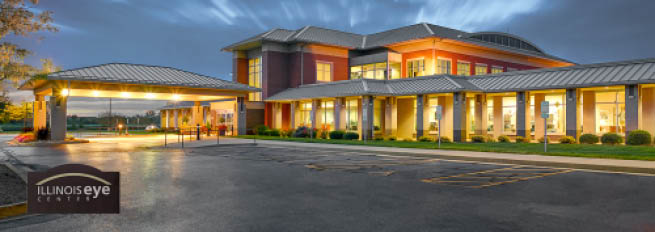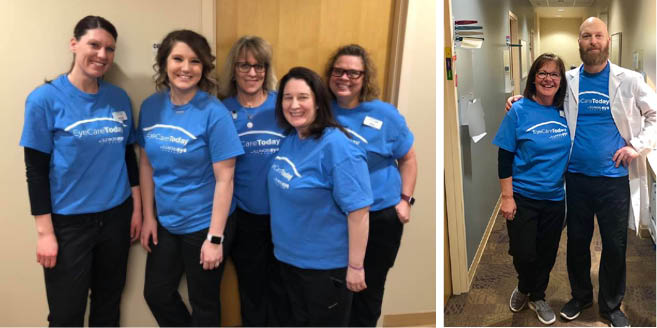In March, Illinois Eye Center opened the doors to EyeCareToday, a same-day eye care clinic based out of the practice’s Peoria location (Figure 1). This initiative was developed to serve patients aged 5 years and older who have acute or urgent eye conditions or need routine vision examinations. Each day, an eye care provider from the Illinois Eye Center is designated to see all same-day appointments and patient walk-ins. I recently touched base with members of the EyeCareToday team to discuss the ins and outs of this unique patient care model.

Figure 1 | In March, Illinois Eye Center opened the doors to EyeCareToday, a same-day eye care clinic based out of the practice’s Peoria location.
Who’s Who
Jill Maher, MA, COE | Principal Consultant, Maher Medical Practice Consulting
Tim McCormack | Executive Director, Illinois Eye Center
Ashley Clark | Marketing Coordinator, Illinois Eye Center
Abby Ault | Clinical Operations Director, Illinois Eye Center
Jill Maher, MA, COE: Can you share with us the origins of the EyeCareToday initiative?
Tim McCormack: Abby and I are both relatively new to Illinois Eye Center. We’ve been here for about 2 years and have backgrounds in primary care and acute care. Prior to joining the practice, we worked in the local hospital systems. When we started at Illinois Eye Center, we were new to ophthalmology, and we began looking for different ways of doing things. Simultaneously, our area was experiencing a proliferation of acute care efforts across medical specialties. Abby and I began considering the ways in which we could better accommodate our patients and provide them with the same level of access they can get with primary care. Ultimately, that meant opening a clinic designated to both urgent eye care and routine examinations.
Abby Ault: Previously, if a patient called about an urgent issue, we had processes in place for the patient to be sent to a triage nurse and be evaluated by phone. At that point, the triage nurse would have to fit the patient into one of our already-packed provider schedules, which frequently caused fairly significant disruptions for the provider and staff. Although the old process “worked,” it was time-consuming and inefficient, which led to overall delays and forced our providers and staff to work longer hours.
On the other hand, if the patient’s concern was something like, “My eye has been bothering me for a couple of weeks,” we would schedule the patient for the next available appointment, which might be the same day or later in the week. Patients didn’t necessarily want to wait, so they would go to the emergency room or to an urgent care clinic. Because Illinois Eye Center is on call for the local hospitals, we would often receive calls from their emergency departments about ocular issues that we could have better treated in house, with the proper equipment. We are hopeful that patients will now choose to call us, or walk in, before going to the emergency departments or urgent care settings, which should save our patients time and money.
Tim: To be honest, it was a perfect storm in that we had three new physician providers starting at generally the same time over the past 8 months. We therefore had some capacity to experiment with provider schedules, and we found that we could dedicate one optometrist per day to the acute care patients. It was a combination of the right circumstances that enabled it to all come together.
Jill: So, staff members of the Illinois Eye Center are assigned a day at the EyeCareToday clinic?
Abby: We have seven optometrists who are assigned a full day to run the clinic, but the shifts are not equally distributed. Our newer providers who are trying to establish their practice work in the clinic more frequently than our established doctors who have a full patient load. The goal is for the newer providers to add patients to their panel by meeting them through this avenue.
Jill: What types of patients utilize EyeCareToday?
Tim: We encourage patients to visit EyeCareToday if they experience newly developed sensitivity to light, sudden vision loss, burning sensation on the eye or eyelid, something stuck in the eye, floaters, flashes of light or shadows obscuring their vision, or itchy eyes. However, patients may need to see additional members of the Illinois Eye Center medical team based on their examination findings.
Fortunately, in addition to the seven optometrists, we have 12 ophthalmologists on staff. If the optometrist running the EyeCareToday clinic encounters something that is beyond his or her scope of practice, he or she can readily access a specialist to obtain insight or to refer the patient for specialized care. Further, it is important to note that EyeCareToday is not a substitute for visits to a specialist for the management of chronic conditions, and we communicate this to patients.
Jill: Are the individuals who present to EyeCareToday typically new or existing patients?
Abby: We see a combination of both new and existing patients. We have yet to do any substantial marketing on this campaign, but we average about 20 patients per day at EyeCareToday. Of those, about two or three are new to the practice. But the rest have been to the Illinois Eye Center in some capacity—they may not be established patients, but they have visited us before.
Jill: From a customer service standpoint, what has patient perception been like to this same-day access to eye care?
Abby: Illinois Eye Center has always provided same-day visits for patients, but this is a new and improved patient care model; it is much more streamlined than what we had done in the past. So far, we have received very good feedback from patients. Again, we have not executed any substantial marketing efforts, so most of the people are pleased to learn they can be seen that day. Of course, some days are busier and therefore less efficient than others. But overall, patients are seen in a timely manner and their problems are addressed quickly.
Tim: It’s a new concept. For years, we had a sign on our front desk stating that patients are seen by appointment only—no walk-ins. We actually didn’t pull that down fast enough. Now we want walk-ins. We want people to feel like, “Hey, I have time today. I’m in the area. I can pop in and be seen.”
Jill: Have there been any other marketing efforts to promote the clinic?
Ashley: We made t-shirts advertising EyeCareToday. Staff members of the Illinois Eye Center wore those t-shirts once a week throughout the first 3 to 4 weeks (Figure 2). Aside from calling in to the office, that is how most patients found out about the clinic initially.

Figure 2 | Staff members of the Illinois Eye Center wore t-shirts to spread the word about the EyeCareToday clinic.
Jill: In this whole experience, what were the major challenges you had to address?
Abby: At first, the biggest challenge was adjusting our mindsets. With the practice, we are used to a set number of patients with scheduled appointments, and we know what each day looks like before it begins. With EyeCareToday, we have had to give up that control. The physician staffing the clinic cannot prepare for the day ahead because he or she does not know which patients will be on the schedule. Going into the day without a set plan has been a major adjustment for our providers.
Previously, we had many policies and protocols for our call center and our front-desk staff to follow. We determined that patients could only be seen that day if they called in with certain conditions. If the patient’s condition was not on the list, the front-desk staff members had to go to a nurse to triage. Now, the front-desk staff can say something along the lines of, “Thanks for calling in. We can see you at 10, 2, 3—you pick.” We have seen some major benefits here: Our nurses are no longer drowning in phone calls, and we are able to create efficiencies in other areas of the practice.
We are still tweaking our processes on a regular basis. Because we are a multispecialty facility and the optometrists are primarily running the EyeCareToday clinic, we don’t want patients to mistake this option as a replacement for their specialist appointments for chronic conditions such as glaucoma or macular degeneration. The onus is on us to educate patients, and, although our marketing has been fairly limited, we have spent a lot of time trying to craft the right message so that patients truly understand what EyeCareToday is for.
Jill: If a practice were interested in implementing a similar model, what advice would you give?
Tim: We pulled this project together in about 3 months. It was a quick turnaround once we got the doctors’ buy-in. We pitched them the idea, they bought into it, and then we wanted to get it started in February, when the pace of the practice was a bit slower. In order to do that, we created a planning team that met weekly, if not biweekly, with different departments and representatives to work through the process ahead of time. We included one of the optometrists as a representative. The ability to work with the optometrists from the start, have the support of the physicians, and get all of the different departments involved was a huge part of making the launch go smoothly.
Abby: Also, at the beginning of our planning, we created a questions page. Any time someone asked a question, we wrote it down so that we would not forget. Then we committed to answering all of these documented questions before going live. Some of our early questions were: “The patient calls in, who is talking to them? What does that staff member need to know?” Once we had those answers, we asked, “The patient walks in; what does the front-desk staff need to ask?” We looked at every angle of the patient encounter and added the ensuing questions to our working document. That document has reached almost 13 pages and lives on our company Intranet. It can be accessed by anyone who works at the practice and has become a resource that we continue to update over time.
Tim: When we first started, our planning team met every morning of the first 2 weeks so that we could evaluate the day before and discuss what worked well, what did not work well, and what we needed to think about. Again, it was the entire team that got together, including the optometrist who had worked the previous day in the clinic. Because we had those meetings, an issue didn’t go on for weeks left unresolved; we were able to collect immediate feedback and implement a solution.
Jill: Sounds like you all did your due diligence.
Tim: From the beginning, we wanted to track measurable statistics and metrics and use that data to make decisions, rather than relying on anecdotes or one-off occurrences. We wanted to monitor what time patients come in, what time they call, which days of the week are the busiest—whatever the metric, we wanted to track it so that we could slice and dice the data and make informed decisions.
Additionally, we committed to not making knee-jerk reactions and blowing up whatever plans we had in place until we had data to support making a change. Maybe something didn’t go perfectly, but that might have been the anomaly, not the norm. It requires a certain amount of stamina to stick with that approach. We have made a couple tweaks, but we haven’t had to start over at all.
Jill: In terms of insurance, how are these visits billed?
Abby: Billing has not changed—an EyeCareToday visit is billed the same as a regular scheduled appointment. Patients do not receive an increased rate because they came in on short notice. We bill as an ophthalmology practice, not an urgent care practice, and we use the same visit codes. Patients pay their specialty copay, and we bill it to their insurance in the same way we do with scheduled appointments.
Tim: It could have been a patient dissatisfier to offer this same-day service but at an increased rate. We’re not doing this so much to make money as to provide better access to care.
Jill: What’s next for EyeCareToday?
Tim: Currently, the clinic operates Monday through Friday, from 8:00 am to 3:30 pm. Depending on what the data suggest, we may look into expanding our hours. Or, if the volume is there, we could potentially open a clinic in another location or have two EyeCareToday providers staff the clinic on certain days. We have talked about our ability to expand if we need to.
We are also gradually increasing our promotion of the concept and the clinic. We haven’t done any print, television, or radio advertisements, but we have done promotions on Facebook and on our website (www.illinoiseyecenter.com). Internally, we have posters in our waiting rooms and are sending out bill stuffers. Overall, our marketing efforts have been kept to a minimum, yet we are still clearly meeting a need of our current patients plus external patients who we did not serve before. We are excited to see what happens when we open the floodgates—we haven’t debuted everything just yet, but we’ve already doubled the number of “same-day” patients we saw last year during the same time period!



